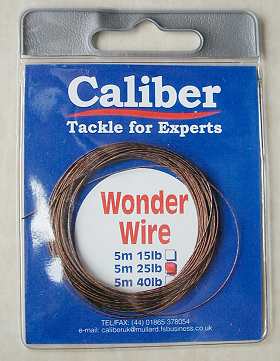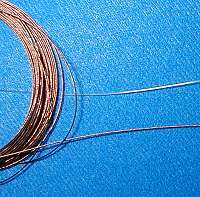Wonder Wire comes in three breaking strains and it isn’t cheap. At £ 4.95 for five metres, it’s around five times the cost of wires made by Fox and Drennan.
|
|
| |
Take it out of the packet and you won’t believe it’s wire. It looks morelike thick cotton or braid. But wire it is, 49-stranded wire, and suppleenough to tie knots in – up to a point.
While a simple overhand loop knot will hold it fairly strongly, therecommended three-turn grinner or blood knot pig tails the wire as you pullit tight.
Twisting doesn’t work either, because the wire is so supple it comes undonewhether you use a twizzling stick or spin it round with forceps.
In the end, I reverted to my usual half-hitch/crimp for the bottom trebleand a knotless knot for the top hook. Fiddly but well worth the effort.
I’m sure I don’t get half as many dropped and missed takes from notoriouslyfickle zander when I’m using it, so if you fish for spikeys you’ve got togive it a try.
Despite initial reservations about going so light, I haven’t managed to bustit on a fish yet either – not even the occasional bigger pike which put inan appearance from time to time when you aren’t expecting them.
|
|
| |
It’s slightly thicker than the 30lb Fox Easy Twist that seems de rigeur atthe moment, but it’s far more supple.
Why sacrifice 5lbs of breaking strain for a bit more suppleness – especiallywhen you have to sacrifice several bob to do it..?
The beauty of this wire lies in its kink resistance. With several otherwires you have to change trace after every fish, because even a jack leavesthem twisted up all over the place.
While I’d change trace if there was the slightest kink or nick in it, thereare times when you want to get a bait back into the water fast and ninetimes out of 10 a couple of jacks won’t have you reaching for the rig binwith this stuff.
I also feel safe on those rare occasions when I hit a better fish on it.Your traces take a pounding off bigger pike for obvious reasons and I’venever had the 25 go on a fish.
Some people think the softer wire gives them an edge on pressured waters.I’ve never thought it makes that much difference with pike, but if it makesyou more confident there’s reason enough to use it.
Caliber is also available in a 40lb bs. I must admit the thickness put evenme off, although I suspect lure anglers who want a robust wire without goingto the jerk-baiters’ extreme of 100lb bs muskie leaders might find a goodhome for it.
I started off saying I wasn’t 100 per cent happy with any wire, but I’lladmit my only real gripe with Caliber is the cost.
If they could knock it out cheaper, it would probably find its way into a lot more tackle bags.
Available from some Tackle shops. Or phone 01865 378054.
E-mail: caliberuk@mullard.fsbusiness.co.uk
NOTE:
Chris makes his traces by forming a hitch round the eye of the bottom hook.He passes a loop through the eye, then pulls the hook back through it andtightens it carefully until it sits snugly on the eye.
He then fastens the loose end down with a crimp and sheaths the join in aninch or so of 2mm silicon to stop the hook flapping about and keep thepoints in the same plane as the wire.
“The crimp doesn’t take the load on the hook, the hitch does,” he explains.
“If you tighten it down right it’s only holding the loose ends together.”
The top hook – treble or double – is attached via a knotless knot and theswivel is attached in the same way as the bottom hook.
“You have to be careful with the knotless knot with a supple wire likeCaliber, because the coils can work loose if you don’t tighten them down asyou pass the wire back through the eye,” he says.
“For extra security you can drop a blob of super glue or Araldite rapid onthe whipping, or slide a section of silicone or shrink tube down the shankbefore you fix the swivel on.”
Whatever wire you use, you should check it after every fish and replace it at the slightest sign of damage.















